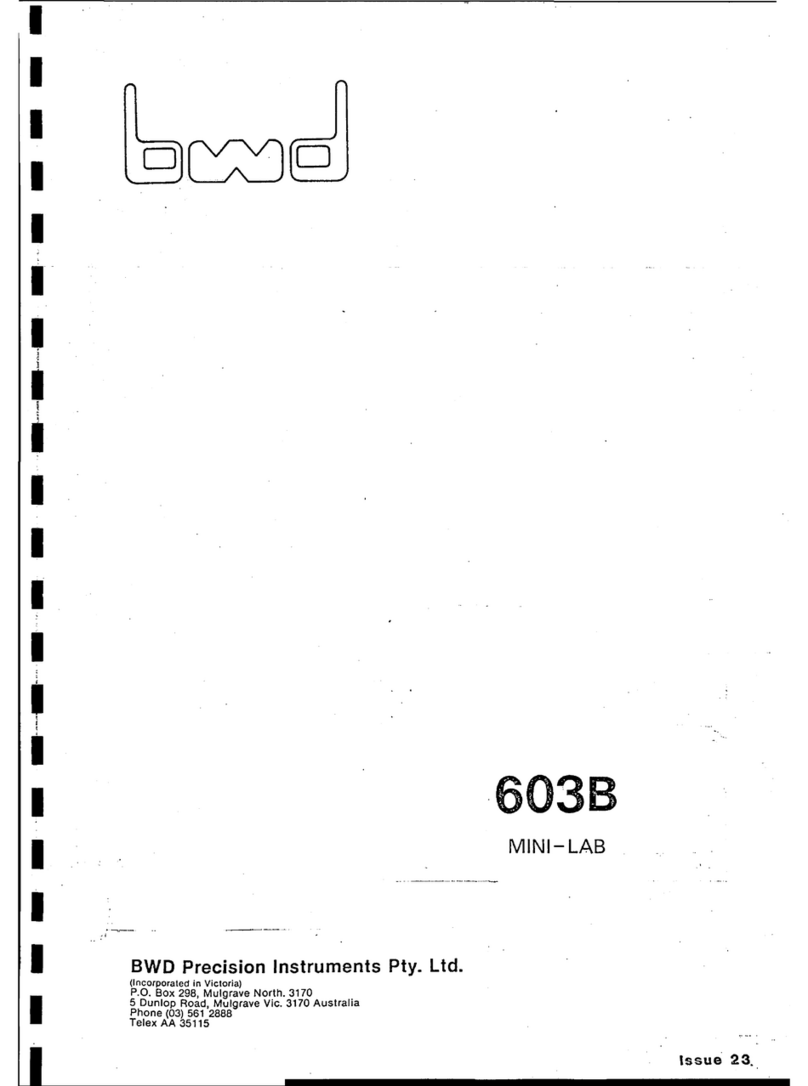
2.PERFORMANCE :
Funcfion Generafor :
2.1 Waveform: Sine, triangle or square, pulse and ramp with amplitude or
frequency modulation.
2.2 Frequency range: 8Decade ranges calibrated from 0.01 Hz to 1MHz plus a
200kHz to 2MHz range. An additional uncalibrated section of the dial
extends range to 0.001 Hz. Dial covers 2decades on each range.
Calibration: ±3% of full scale lOHz -IMHz.
2.3 Voltage output: Two simultaneous levels 10 Volts p-p open circuit, 5Volts p-p
into 600Q.
1Volt p-p open circuit, 0.5 Volts p-p
into 600Q.
Variable output provides continuous control of >100:1 of both outputs whilst
maintaining aconstant 600Q output impedance. Outputs, overvoltage and
short circuit proof.
Sinewave output level :Less than ±2% level variation over calibrated frequency
range into 600Q ±5%between 1and 2MHz.
2.4 Output offset: Output normally centered symmetrically about ground. Push/pull
switch applies acontinuously variable 0to ±5 Volts offset voltage on open
circuit. Control also doubles as ramp frequency control (see 2.8 below).
NOTE: 0-1 Voutput has ±0.5V offset.
2.5 Syr.in'.otry (fixed): ±2% from O.OlHz to 1MHz (calibrated portion of dial).
Symmetry (variable) :Pulse or ramp waveforms. Continuously variable from
1:1 to over 1:50 or 50:1 by switch selection. Applies to sine, triangle or
square waveforms. Variable control also doubles as ramp amplitude (see 2.8 below).
2.6 Sine wave distortion: <1.5% lOHz to >50kHz <2% at IMHz (typically
0.6% 20Hz to 50kHz).
Square wave rise time: lOOnsec into 600Q load and <50pf capacitance.
Triangle linearity: >99% within calibrated range on dial up to lOOkHz.
Triangle symmetry: Better than 2% within calibrated range up to lOOkHz.
2.7 Frequency modulation: Function Generator can be swept over 2decades by the
internal ramp generator or over 4decades by an external log sweep. It can
also be used as an externally programmed oscillator over a10,000/1 frequency
range.
Input: 1Volt/dial division.
Input impedance: 25KQ.
Linearity: 2%.
Input frequency: DC to >10kHz.
2.8 Sweep ramp generator:
Output voltage: 0to >+10 Volts with acontinuously adjustable upper limit
from +0.6 to +10 Volts using the variable symmetry control in the OFF mode.
Ramp duration :>4 sec to 65m sec approximately.
Continuously adjustable by the OFFSET control in the OFF position.
When coupled into the FM socket, the Function Generator will sweep from the
frequency selected by the dial up to the frequency set by the ramp amplitude
control. An automatic circuit prevents the sweep exceeding the dial range.
Horizontal drive to oscilloscope or recorder is also taken from ramp output
via the voltage amplifier (see 2.14) to set drive voltage and polarity required.
2-1
603b




























